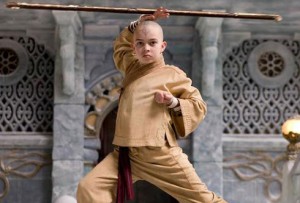
Probably not the career killer that it could have been for director M. Night Shyamalan, the kid-friendly but emotionally cold THE LAST AIRBENDER will leave viewers thoroughly unsatisfied and TV show fans steaming.
Based on the long-running animated television series, THE LAST AIRBENDER follows the adventures of Aang (Texas-born actor Noah Ringer), who is a little boy with the power to bring balance to his world. The setting is a mystical place where the spirit world has empowered certain human inhabitants with something referred to as “bending” abilities. Aang has mastered the ability to bend the air but cut his education as to the others (earth, water, and fire) short when he was told that he was the famed Avatar. You see, the Avatar is a unique being capable of bringing together all the bending arts thus uniting the world. The cost of this responsibility is high–Aang cannot have a family if he takes his role as the Avatar. And when Aang runs away from his trainers and hides under the waters of the ocean (yes, that’s how it is phrased), 100 years of chaos ensues. This imbalance permits the Fire Nation (benders of the flame) to take over with their amazing combustion driven machines. Only Aang’s return from his self-imposed exile can set things right again.
THE LAST AIRBENDER is clunky and poorly adapted. The dialogue feels as though it was taken directly from a Saturday morning cartoon (and not the well-thought of source material). At times writer Shyamalan’s stilted prose elicited unintended chuckles from the audience—I shook my head in disbelief. Few actors, even mega-talent Dev Patel (of SLUM DOG MILLIONAIRE here playing fire-bending Prince Zoku), are given the chance to emote, rather, they spend most of their time on screen explaining everything. The constant exposition is exhausting as written narration is followed up by voice over narration and the characters themselves comment on the story with little pathos or interest. The dispassionate objective of the script is to set-up the world of this first of three films not through showing it to us, but by telling us about its awesome history. This lazy style of story-telling, especially in our visual era with the controversial addition of 3D, is anything but awesome. But what’s worse is that from the very beginning we’re told this is Book One as in one of three! Similarities to the ill-fated THE GOLDEN COMPASS are fair although COMPASS is surprisingly a far better film.
Given my limited experience with the TV series I can only imagine that fans of the animated version will be unhappy. Certainly this is not the film they would have wanted. Originally bearing the Avatar title, the idea of bringing the popular series to the screen had great promise, particularly in world-wide release. But the casting here of largely non-Asian actors has created a controversy now being referred to as “racebending” that may hamper its overseas performance. I’m not sure what the race of the main characters were in the series, but the casting in the film is oddly inconsistent. The benders are described as being from various “tribes” which would likely mean that each tribe would have their own unique racial identity. It is our racial identity that has sadly divided us throughout history, but as we have learned through enlightened thought, diversity is power and strengthens all facets of our existence.
That is why it is so troubling that in this movie race is pushed to curb with utter indifference. The only consistent race on display is that of the Fire Nation who all appear to be of Indian or Middle Eastern descent. This well-publicized controversy is a valid problem from the opening scene that appears to be set in an Alaskan type village where our heroes are Anglo but the rest of the inhabitants are of Inuit background. Why was it necessarily to cast things this way? It just feels out of place and weird. The racial incongruities continue and make little sense. After the complaints associated with casting choices in THE PRINCE OF PERSIA, AIRBENDER will only feed the flames.
But are the special effects worth the price of admission? Although there are moments of grandeur, the answer is no on both a technological and narrative level. The addition of 3D adds little to the film that looks forced in a way less convincing than CLASH OF THE TITANS. Like TITANS, AIRBENDER was retooled after it was completed to accommodate the 3D gimmick. And instead of taking advantage of the wonderful “bending” abilities to thrill viewers, writer/director Shyamalan chooses tease us until what promises to be the big conclusion. And instead of building anticipation, I found myself increasingly frustrated as little battles are a combination of hand-to-hand combat and bending techniques. The disconnect between the advancement of the plot and the magical abilities that should be driving it is hard to put a finger on. The movie is just not breathtaking at any point. My thought is that the fault lies squarely on Shyamalan’s shoulders, but for the awkward and expositive dialogue that relies on explanation rather than emotion and action, the special effects would have meant more to the viewer by wowing us rather than just painting the scenery.
One wonders whether the inevitable financial failure of THE LAST AIRBENDER (which reportedly had a budget of well over $200 million) will force M. Knight Shyamalan back to smaller character and story-driven films that take advantage of his affection for mystery and fairytale. Bigger has not been better for Shyamalan. And while AIRBENDER is supposed to start a franchise, it is not likely that such a series will flourish theatrically. In fact, I’d be surprised if there would be financial backing for another installment. Like THE GOLDEN COMPASS, THE LAST AIRBENDER could be the last of its line.

